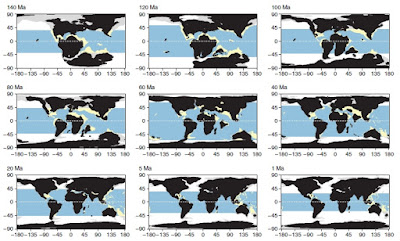Plate tectonics drive tropical reef biodiversity dynamics- Fabien Leprieur, Patrice Descombes, Theo Gaboriau, Peter F. Cowman, Valeriano Parravicini, Michel Kulbicki, Carlos J. Melian, Charles N. de Santana, Christian Heine, David Mouillot, David R. Bellwood & Loıc Pellissier
Interesting work!
Tropical coral reefs require sunlit shallow sea water to thrive. This is provided by coastlines and continental shelf areas. Plate motions has shifted continents. The geography of shallow sea habitats in which corals thrive has accordingly shifted. This study reconstructs this dynamic over the past 140 million years of the breakup of Gondwanaland and the movement of continents since. It is summarized beautifully in this graphic.
Source: Leprieur et al 2016
The optimum locations of coral habitats moved as the configuration of the Tethyan ocean changed. The fossil coral record shows that coral diversity was maximum in the Western Tethys in the Eocene (55 -33 ma), then shifted to the Arabian Peninsula and Western Indian Ocean during the Late Eocene - Oligocene (37-15 ma). Finally as the Tethys Ocean closed due to the India Asia collision, coral biodiversity hotsposts shifted since the middle Miocene to the Indo- Australian Archipelago.
There is a further step. The study models species diversification based on the distribution of estimated paleo-bathymetry and the residence time of habitat (both controlled by plate tectonics). The reasoning is that the frequency of evolution of new species (biodiversity) depends on the distribution of optimal habitat and how long these habitats remain in place. Large long lasting shallow continental shelves will offer an opportunity for populations of ancestral species to disperse over broad areas and diverge into new species. Tectonically complex areas like western Tethys (in the Eocene) and Indo-Australian Archipelogo in Pliocene-Quaternary have sea floor topography and shelf configurations which fragments habitats based on changes in water depth, current and wave strength and direction and nutrient availability. Populations get split and isolated in such regions leading to genetic divergence and speciation. This is mimicked well by the simulations. Over time, rich diversity can evolve in such long lasting optimas by the process of dispersal and isolation. The locus of evolution of biodiversity can then shift as plate motions move ideal habitats across the globe. New species can arise from parapatric speciation (adjacent to the range of the ancestor) or sympatric speciation (within the range of the ancestor). The study finds that for either modes of speciation, their simulation matches the observed distribution of fossil and extant coral diversity.
The graphic below captures the comparison between fossil coral diversity and simulated coral diversity. Eocene, Miocene and Quaternary observed diversity (left side) matches the model results (right side).
Source: Leprieur et al 2016
The scientists caution that local fluctuations like sea water temperature and acidity and ecological complexity will also play a role in evolution of diversity and call for further validation of their work. But overall, its a nice demonstration of the role of plate tectonics in controlling coral habitats and diversity.
Interesting work!
Tropical coral reefs require sunlit shallow sea water to thrive. This is provided by coastlines and continental shelf areas. Plate motions has shifted continents. The geography of shallow sea habitats in which corals thrive has accordingly shifted. This study reconstructs this dynamic over the past 140 million years of the breakup of Gondwanaland and the movement of continents since. It is summarized beautifully in this graphic.
Source: Leprieur et al 2016
The optimum locations of coral habitats moved as the configuration of the Tethyan ocean changed. The fossil coral record shows that coral diversity was maximum in the Western Tethys in the Eocene (55 -33 ma), then shifted to the Arabian Peninsula and Western Indian Ocean during the Late Eocene - Oligocene (37-15 ma). Finally as the Tethys Ocean closed due to the India Asia collision, coral biodiversity hotsposts shifted since the middle Miocene to the Indo- Australian Archipelago.
There is a further step. The study models species diversification based on the distribution of estimated paleo-bathymetry and the residence time of habitat (both controlled by plate tectonics). The reasoning is that the frequency of evolution of new species (biodiversity) depends on the distribution of optimal habitat and how long these habitats remain in place. Large long lasting shallow continental shelves will offer an opportunity for populations of ancestral species to disperse over broad areas and diverge into new species. Tectonically complex areas like western Tethys (in the Eocene) and Indo-Australian Archipelogo in Pliocene-Quaternary have sea floor topography and shelf configurations which fragments habitats based on changes in water depth, current and wave strength and direction and nutrient availability. Populations get split and isolated in such regions leading to genetic divergence and speciation. This is mimicked well by the simulations. Over time, rich diversity can evolve in such long lasting optimas by the process of dispersal and isolation. The locus of evolution of biodiversity can then shift as plate motions move ideal habitats across the globe. New species can arise from parapatric speciation (adjacent to the range of the ancestor) or sympatric speciation (within the range of the ancestor). The study finds that for either modes of speciation, their simulation matches the observed distribution of fossil and extant coral diversity.
The graphic below captures the comparison between fossil coral diversity and simulated coral diversity. Eocene, Miocene and Quaternary observed diversity (left side) matches the model results (right side).
Source: Leprieur et al 2016
The scientists caution that local fluctuations like sea water temperature and acidity and ecological complexity will also play a role in evolution of diversity and call for further validation of their work. But overall, its a nice demonstration of the role of plate tectonics in controlling coral habitats and diversity.



No comments:
Post a Comment